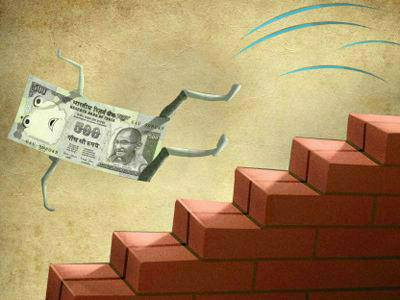The Indian rupee plunged dramatically on Tuesday, August 27, slumping 4.66 per cent in a matter of a few hours to yet another historic low, of Rs18.30 against the UAE dirham (Rs67.23 against the US dollar), baring the rout in the currency, which is now down more than 23 per cent since the beginning of the year.
In fact, the rupee has lost more than 25 per cent of its value in less than four months, since May 2, 2013, when it traded at Rs14.61 against the UAE dirham. With this latest slump, the rupee has lost more than half its worth (52.62 per cent) in 25 months. The rupee traded for Rs11.99 against Dh1 on July 29, 2011, and within two years, the emerging market currency has slid to a record Rs18.30 against Dh1 today.
Today’s decline came after the Indian Parliament approved a $20-billion food security bill, sending a clear signal to international investors that the country’s government is not serious about controlling the ballooning deficit and, ahead of next year’s general elections, will continue to take populist measures at the expense of the country’s economic health.
Mirroring the global rout in equities this morning, India’s benchmark BSE Sensex index slumped by more than 3 per cent today and closed at 17,968 points, a slump of almost 600 points, and down 3.2 per cent.
As the Indian rupee continues to weaken to record levels against the US dollar and dollar-linked currencies such as the UAE dirham, non-resident Indians (NRIs) in the UAE and across the Gulf region are seen binge-borrowing in their host countries to remit record sums of money to their home country.
India currently finds itself in an unenviable situation, caught as it is between the unholy trinity of slowing economic growth, a mounting fiscal deficit, and a plunging currency. Most international analysts believe it is becoming increasingly tough for the emerging market giant to meet its balance of payments obligations, which is leading to a loss of faith in its currency.
After a semblance of recovery late last week, the rupee once again began its southward journey this week, slumping below the Rs17.50-mark vs. Dh1 (Rs64.31 vs. $1) yesterday and breaching the Rs18-mark today as month-end dollar demand weighs heavily on the emerging market currency, besides a fundamentally weak Indian economy.
The rupee breached another significant milestone today on its way down, slumping below the Rs67-mark against the greenback and landing at Rs67.23 vs. $1 (Rs18.30 vs. Dh1) at 4.50pm UAE time (12.50pm GMT).
This continuing decline has led to a surge in remittances by Indians based in the UAE and across the Gulf, with UAE Exchange, one of the largest remittance houses in the world, estimating the surge at 6 per cent just in the past two months.
“The continuous dipping of INR has resulted in a 6 per cent increase in remittances over the past two months,” Y Sudhir Kumar Shetty, COO – Global Operations, UAE Exchange, told Emirates 24|7.
The Indian rupee continues to make and break new records on a daily basis, with the beleaguered currency once again slumping to new lows in early trade today, and banks in the country are luring expats with “low personal loan rates” for remitting and investing in India.
“Avail a personal loan at low rates & invest in NRE Fixed Deposit at our partner banks in India at higher interest rates,” reads a text message we received just this morning, encouraging us to leverage the arbitrage opportunity arising out of higher interest rates in India than here in the UAE.
Additionally, a number of Indian expats will be eyeing the real estate opportunity back home, with properties becoming that much cheaper in dirham/dollar terms with a plunging rupee.
India is already the world’s largest recipient of remittances by its overseas nationals, with NRIs remitting $69 billion in 2012.
With the ongoing rupee weakness, that number is set to surge in 2013, says Shetty.
“The first half of 2013 witnessed a growth of 12-15 per cent in remittances, when compared with that of 2012,” he says.
“The further weakening of rupee will make remittance flow grow by 15-20 per cent in the coming months. So the expected remittance flow towards India in 2013 will be around $84-85 billion, of which 60 per cent is expected from the GCC,” he reckons.
As NRIs continue to borrow in dirhams and dinars across the Gulf to remit money home, Shetty has a word of caution for Indian expats.
“The trend of borrowing money is there for the last two to three years. People are using different means to borrow maximum money to send back home – be it bank loans, credit card withdrawals, savings etc. which leads to over leverage of individuals, which is a very disturbing trend,” he says.
The currency’s slide continues even as the central bank, the Reserve Bank of India (RBI), has taken a number of fresh measures to pump the country’s banking system with fresh liquidity in order to avoid a cash-crunch crisis.
Importers in the country have been struggling to cope with increased demand for US dollars as they need to spend more rupees per greenback for bringing in oil and other essential goods into the country.
In addition, the heightened probability of the US Federal Reserve withdrawing its bond-buying programme in a phased manner starting next month is also weighing heavily on the rupee as well as other emerging market currencies, some of whom have in the past benefitted from America’s dollar-printing binge.

